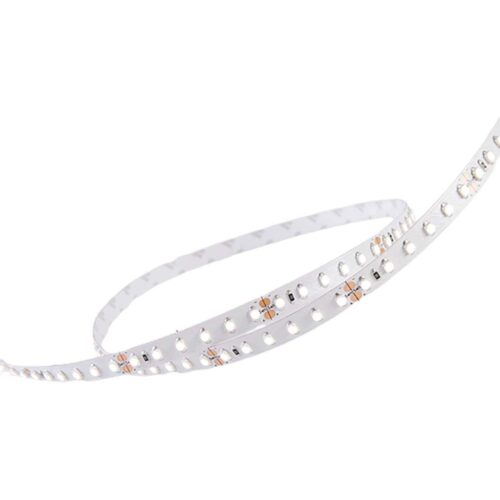
Stair Lighting
Enhance your staircase with LED lighting to provide your home with an elegant and modern look.
Enhance your staircase with LED lighting to provide your home with an elegant and modern look
With LED lighting in your stairs, you will not only enhance safety and comfort in your home, but you will also reduce your electricity bill, as LED lighting uses less energy and lasts longer than traditional light sources.
Installing LED lighting in your stairs is easy, and it will provide a fantastic visual expression that will impress both you and your guests. Let LED lighting illuminate your home and give you a great experience as you go up and down the stairs.
Our LED strips are easy to place, allowing you to be creative with positioning and applications.
A stairs step typically has a width of between 100 and 150 cm. To determine the length you need, you should measure the width of your step and how many steps you wish to illuminate.
The LED strips come in ready-made lengths so that you don’t have to cut unnecessarily:
- 500 cm
- 150 cm
- 120 cm
- 100 cm
The LED strips can be cut every 5 cm, allowing you to customize the length to fit your step perfectly. All LED strips are ready to connect and come with a 1-meter connection cable.
We have reduced the wattage to 3W, providing the right amount of light for illuminating under the steps.
LED technology has experienced remarkable growth in recent years.
We are observing an increasing trend where more and more people are choosing low-voltage LED lighting for their homes, whether to create special atmospheric effects or as a versatile lighting source.
We understand that navigating through the vast array of LED technology and solutions can be challenging. That’s why we have made it easy for you to select the right product. We offer a range of LED strips in various types, qualities, and price ranges, carefully chosen with the consumer market in mind.
All our LED strips have 60 LEDs or more per meter, ensuring even and pleasant lighting. Additionally, the strips have a color rendering index of over 90 (RA90+), which means they reproduce colors more accurately than most other LED strips on the market.
Choose the right type of LED strip and the number of meters you need, along with the appropriate LED driver and quantity. If you desire dimming capabilities, we also offer a selection of dimmers and any switches or remote controls.
We know that LED technology and its countless solutions can be difficult for many to grasp, so we have tried to make it easy for you to choose:
Do this:
- Choose the type of LED strips you need
- Count and measure your steps
Measure your steps to decide how many meters you need- Choose you LED-driver
- If you wish to dim the lights, select a dimmer and possibly a switch - or choose the automatic control for automatic lighting in your staircase
Nice to know and need to know about LED-lighting
What is the difference between low voltage and 230V LED-strips?
In short, a 24V LED strip is much more energy-efficient than 230V and 12V options.
Low-voltage LED strips are best suited for indoor use compared to 230V LED strips because they do not flicker like 230V LED strips can.
What IP rating should I choose?
First and foremost, you need to decide where you want to install the LED strips. Will they be installed indoors? Outdoors? Or in wet areas?
The IP rating is a number that indicates how well the LED strip is protected against dust and water. An IP rating of 20 means it is suitable for indoor installation, an IP rating of 67 means it is suitable for outdoor installation, and an IP rating of 68 means it can be installed underwater.
How bright does the light need to be?
The strength of the light source is referred to as Lumens (lm).
Depending on where the LED strip will be installed, the following guidance may be helpful:
- 750-2000 lm = Store, workshop
- 500 lm = Kitchen, bathroom, office
- 200 lm = Hallway, staircase
- 50-200 lm = Living room
P.S.: LED strips can also be dimmed, allowing the light intensity to be adjusted.
What does Kelvin mean?
Kelvin (K) is a number that indicates the color temperature of the light source. Typically, for home use, 2700K is recommended. For garages, offices, construction sites, etc., it is often appropriate to choose a Kelvin rating between 3000K and 4000K.
- 2700K gives a warm white color
- 3000K gives a white color
- 4000K gives a cool white color
What does RGB and RGBW mean?
RGB – Multicolored LED light with the colors red, green, and blue, which together produce 16 million color shades.
RGBW – RGBW corresponds to RGB but can also provide pure white light with a color temperature of 3000K.
What is CRI/RA?
CRI (Ra) indicates the ability to reproduce colors as naturally as possible.
The higher the CRI/RA (color rendering index), the more natural the colors in the room will appear.
For example, if you are illuminating a painting, it is important that the color rendering is high. However, for secondary lighting, such as stair lighting or outdoor lighting, the CRI/RA value is often less important.
What does LED/m actually mean?
LED/m indicates how many diodes are mounted per meter. The more diodes per meter, the more even the light you will get from the LED strip.
In cases where the LED strip is directly visible, it is important to have as many LED diodes per meter as possible to achieve an even result.
However, if you are installing the LED strip in a deep aluminum profile, the number of LED diodes per meter is of lesser importance. In that case, it is more important to consider the brightness (lm).
Driver – do I need one?
Which driver should I choose?
The choice of driver depends on the power consumption of the LED strip you will use and how many meters you will connect.
Example: With an LED strip rated at 4 watts per meter and a length of 10 meters, the total power would be 4W/m * 10m = 40 watts. This is the minimum requirement, and we recommend adding a driver that is 20-30% more powerful.
Is there anything else I should consider regarding the choice of driver?
Yes. All LED strips require a driver, and you need to consider whether you want to:
- Dim the LED strip
- Install it outdoors or indoors


